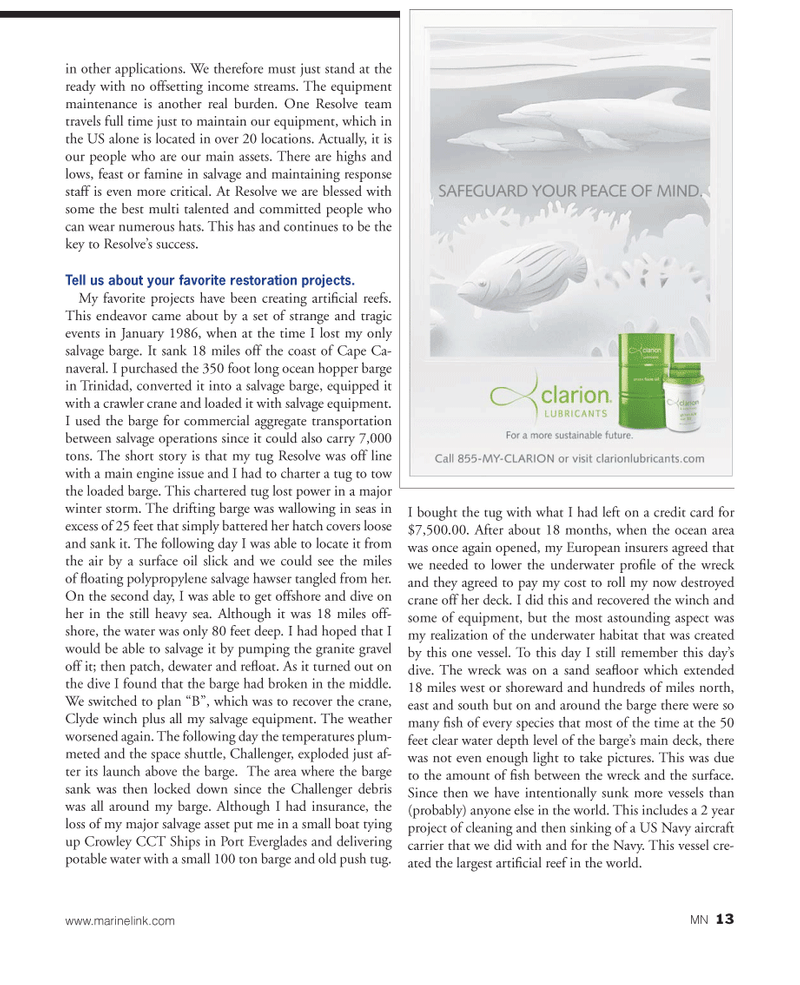
Page 13: of Marine News Magazine (August 2013)
Salvage & Response
Read this page in Pdf, Flash or Html5 edition of August 2013 Marine News Magazine
in other applications. We therefore must just stand at the ready with no offsetting income streams. The equipment maintenance is another real burden. One Resolve team travels full time just to maintain our equipment, which in the US alone is located in over 20 locations. Actually, it is our people who are our main assets. There are highs and lows, feast or famine in salvage and maintaining response staff is even more critical. At Resolve we are blessed with some the best multi talented and committed people who can wear numerous hats. This has and continues to be the key to Resolves success. Tell us about your favorite restoration projects. My favorite projects have been creating arti? cial reefs. This endeavor came about by a set of strange and tragic events in January 1986, when at the time I lost my only salvage barge. It sank 18 miles off the coast of Cape Ca- naveral. I purchased the 350 foot long ocean hopper barge in Trinidad, converted it into a salvage barge, equipped it with a crawler crane and loaded it with salvage equipment. I used the barge for commercial aggregate transportation between salvage operations since it could also carry 7,000 tons. The short story is that my tug Resolve was off line with a main engine issue and I had to charter a tug to tow the loaded barge. This chartered tug lost power in a major winter storm. The drifting barge was wallowing in seas in excess of 25 feet that simply battered her hatch covers loose and sank it. The following day I was able to locate it from the air by a surface oil slick and we could see the miles of ? oating polypropylene salvage hawser tangled from her. On the second day, I was able to get offshore and dive on her in the still heavy sea. Although it was 18 miles off-shore, the water was only 80 feet deep. I had hoped that I would be able to salvage it by pumping the granite gravel off it; then patch, dewater and re? oat. As it turned out on the dive I found that the barge had broken in the middle. We switched to plan B?, which was to recover the crane, Clyde winch plus all my salvage equipment. The weather worsened again. The following day the temperatures plum- meted and the space shuttle, Challenger, exploded just af- ter its launch above the barge. The area where the barge sank was then locked down since the Challenger debris was all around my barge. Although I had insurance, the loss of my major salvage asset put me in a small boat tying up Crowley CCT Ships in Port Everglades and delivering potable water with a small 100 ton barge and old push tug. I bought the tug with what I had left on a credit card for $7,500.00. After about 18 months, when the ocean area was once again opened, my European insurers agreed that we needed to lower the underwater pro? le of the wreck and they agreed to pay my cost to roll my now destroyed crane off her deck. I did this and recovered the winch and some of equipment, but the most astounding aspect was my realization of the underwater habitat that was created by this one vessel. To this day I still remember this days dive. The wreck was on a sand sea? oor which extended 18 miles west or shoreward and hundreds of miles north, east and south but on and around the barge there were so many ? sh of every species that most of the time at the 50 feet clear water depth level of the barges main deck, there was not even enough light to take pictures. This was due to the amount of ? sh between the wreck and the surface. Since then we have intentionally sunk more vessels than (probably) anyone else in the world. This includes a 2 year project of cleaning and then sinking of a US Navy aircraft carrier that we did with and for the Navy. This vessel cre- ated the largest arti? cial reef in the world. MN 13www.marinelink.com MN August2013 Layout 1-17.indd 137/23/2013 7:41:20 PM

 12
12

 14
14
